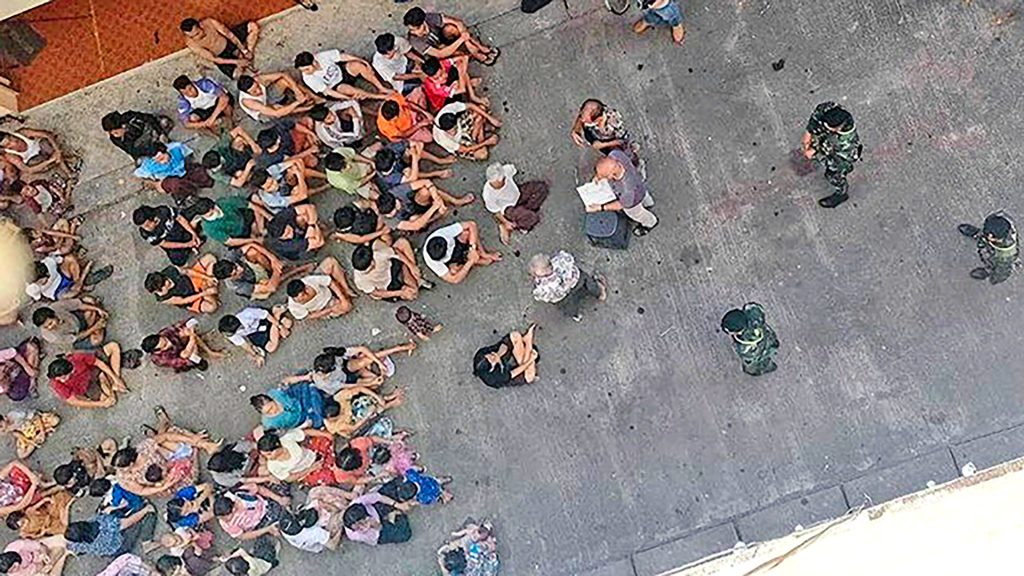Insight Email No. 15
This week’s focus revolves around the repercussions of the devastating Cyclone Mocha and the unfolding dynamics of the warming El Niño phenomenon. Amidst the ongoing challenges in forming a new Thai government following the May election, there is a growing concern regarding the escalating security issues at the Thai-Myanmar border, particularly in Mae Sot. In addition, this bulletin delves into the current state of school enrollment in Myanmar’s new academic year. Despite the authorities’ efforts to mobilize government resources for a dedicated week of student enrollment, the enrollment rate has failed to reach the previous average level, resulting in a significant number of children in Myanmar being deprived of their right to education. This week’s insight email also discusses the issue of climate-change denialism and we also offer a brief introduction to the Transnational Institute (TNI)’s publication on the Nationwide Ceasefire Agreement (NCA) in Myanmar.
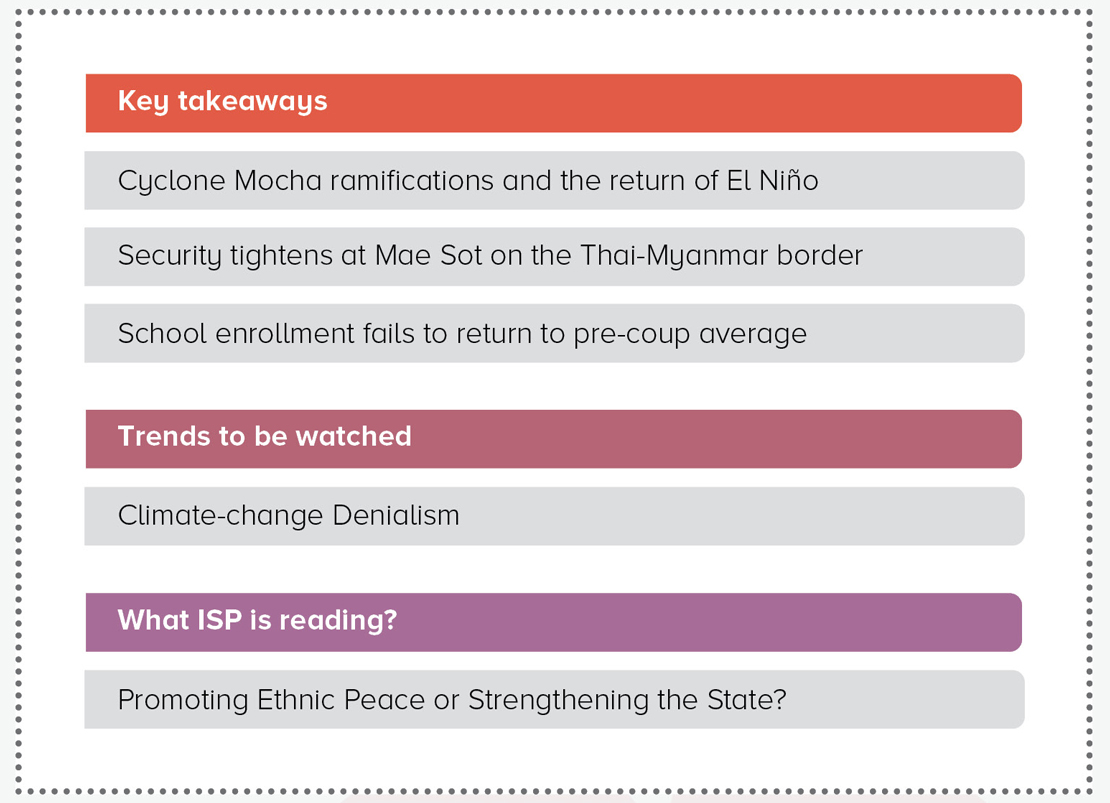
∎ Key takeaways
1. Cyclone Mocha ramifications and the return of El Nino
Super Cyclone Mocha made landfall in Rakhine State and other areas of Myanmar, resulting in significant devastation. The SAC reported a total of 148 deaths caused by the cyclone. While the international community and media have drawn attention to the deaths of more than 400 Rohingya individuals as a result of the cyclone, the SAC has refuted these claims. As of May 18, the SAC officially reported that 91 Bengalis (the official term used by the regime to describe the Rohingya), were killed by the cyclone. The SAC also documented property damages to nearly 200,000 homes and other buildings but has yet to establish a comprehensive financial assessment of the damage. The ASEAN Emergency Response and Assessment Team (ASEAN-ERAT) has estimated that the havoc wreaked by Cyclone Mocha could amount to approximately USD 35 billion, equivalent to half of Myanmar’s 2022 GDP.
The SAC response to the most recent disaster is very similar to its actions following Cyclone Nargis in 2008. The SAC has assigned generals and brigadier generals from the military to lead reconstruction efforts in various townships, with four officers assigned to Chin State, and 14 officers entrusted with leading reconstruction efforts in Rakhine State. While coverage of relief and assistance to Rakhine State are positioned prominently across the pages of state-run newspapers, there are virtually no reports regarding Chin State or other affected areas. Preliminary field reports indicate severe damage in eight townships of Chin State, as well as significant flooding, property damage, and crop-losses in areas of Magwe and Sagaing Regions. Nearly 80 percent of sesame crop fields were damaged in Yinmabin, Pale, and Chaung Oo townships of Sagaing Region. The destruction has also extended to crop storage facilities.
Another notable aspect is the international collaborative efforts for providing humanitarian assistance. The United Nations has issued an urgent appeal for funds amounting to USD 333 million to aid 1.6 million people seriously affected by Cyclone Mocha. The United States embassy in Myanmar has taken swift action, pledging an initial USD 200,000 for relief efforts through USAID, as well as an additional USD 17 million for humanitarian assistance. Emergency relief efforts from ASEAN and neighboring countries are also being mobilized, but concerns persist regarding the freedom of international assistance, its unhindered flow, and equitable distribution among cyclone survivors. In many cases, aid agencies are required to await SAC approval, and there have been reports of relief convoys being stopped at checkpoints. Troublingly, on May 23, while SAC authorities were engaged in emergency relief work in Rakhine State, they arrested five volunteers, including writer Way Hin Aung. The reasons behind the arrests remain unknown, mirroring the restrictions and oppression experienced during the aftermath of Cyclone Nargis in 2008.
Alongside Cyclone Mocha the development of El Niño poses an additional risk of extreme weather events in Myanmar (See ISP OnPoint No. 15). A full transition to El Niño could be possible in June, and will most likely lead to irregular rainfall, a new spike in global warming, stronger storms, and other natural disasters. As the conflict in Myanmar continues to escalate on multiple fronts, the resurgence of El Niño could exacerbate the already precarious situation, leading to more severe weather events, additional humanitarian crises, and amplifying the challenges posed by the ‘Climate Conflict-Humanitarian Triple Nexus’ in Myanmar. It is crucial to seek innovative forms of cooperation to escape the trap of endless climate, political, and humanitarian crises.
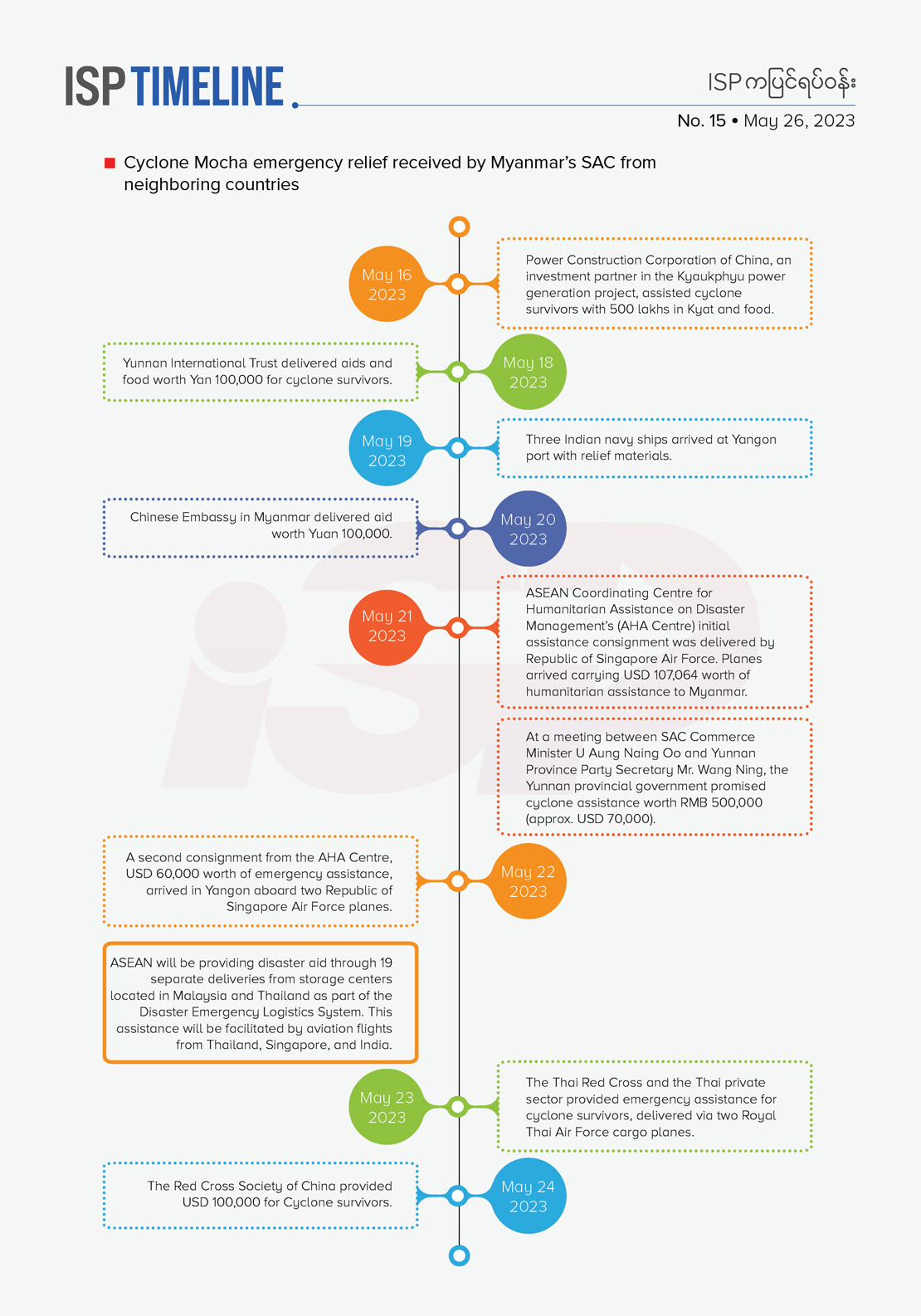

2. Security tightens at Mae Sot, on the Thai- Myanmar border
According to a report by VOA (Burmese), on May 22 Thai security forces established checkpoints throughout various areas of Mae Sot, a town situated on the Thai side of the Thai-Myanmar border. The local population is being subjected to close scrutiny by security forces. Additionally, the authorities have conducted raids on small factories employing Myanmar migrants, resulting in the arrest of at least 70 Myanmar nationals. Thai authorities have imposed tight restrictions following multiple seizures of weapons and related materials.
In one event, Thai police and fire brigade personnel arrived at a location in Mae Pa-Mae Loei housing estate on May 14, after an accidental blast and subsequent fire. During the investigation, security forces discovered gunpowder, pipes, and workshop tools inside a house. As a result, 15 Myanmar nationals residing in the vicinity without proper documents were arrested. However, the owner of the house managed to escape. Another incident took place on the same day when Thai authorities received a tip-off and subsequently inspected a house in a village near the Mae Ramat district, close to Mae Sot. As a result of the inspection, one Myanmar national and two Thai citizens were apprehended, as authorities discovered a firearm and other related materials at the premises. These incidents have prompted tightened security measures in the area. It has been reported that senior Thai officials are scheduled to meet with Dr. Cynthia Maung, who runs a clinic at the border town, as well as with officials from the Karen National Union (KNU).
This tightening of security measures holds two significant implications that warrant analysis. Firstly, it sheds light on the audacious and reckless actions of certain migrants from Myanmar. These activities clearly contravene Thai national laws, and pose threats to both the sovereignty of Thailand and the security and order of the local population. Secondly, it is important to monitor the response from the Thai authorities. Thailand is currently experiencing a critical political juncture, with pro-democracy and anti-military parties having recently secured victory in national elections and now working towards establishing a new government. However, this newly elected democratic opposition is still engaged in coalition-building and vying for power amidst the prevailing influence of the traditional political establishment.
In Thailand’s recent political history, a recurring pattern can be observed wherein the military has tended to create a “security crisis” during periods of democratic transition, responding to elected civilian authorities as threats to its dominant power. This pattern can be exemplified by various incidents. For instance, the Thai southern security crisis emerged during the tenure of Prime Minister Thaksin Shinawatra, while the Democrat Party was in power, leading to events such as the Myanmar embassy siege and the hospital siege in 1999, ultimately requiring military intervention. Similarly, when Prime Minister Samak Sundaravej assumed office in 2008, the border conflict with Cambodia intensified due to competing claims over the 900-year-old Preah Vihear temple complex. It appears that during times of political transition, the Thai military seeks to assert its perceived indispensable role in the nation’s affairs.
While the increased security measures in Mae Sot on the Thai-Myanmar border could be interpreted as a routine security operation, it can also be seen in a broader context as a demonstration of the Thai military’s perceived indispensability in the realm of national security, particularly during this period of political transition in Thailand.
3. School enrollment fails to return to pre-coup average
Myanmar has initiated school enrollment week, taking place from May 23 to 31 for the 2023-2024 academic year with the motto “Every school-age child should enroll for learning opportunities.” Additionally, the SAC recently held a national “Educational Conference” between May 18-20.
At a glance, it is obvious that Myanmar society is deficient in education. According to statistics from the Education Ministry, of the 19.44 million students enrolled at schools during the period from 1999 to 2014, 57.29 percent reached fifth-grade levels and only 40.26 percent reached eighthgrade levels (middle school). According to the inter-censal survey, only 290,000 have completed vocational education and only three million have graduated. Widespread poverty in the country also threatens children’s learning opportunities. In a recent research finding, of every ten children who halted their school education, three needed to help their families and two could not afford to continue studying.
The education situation in Myanmar has significantly deteriorated since the 2021 military coup. It is estimated that approximately 8 to 10 million students have been deprived of education access in the past three academic years since the coup took place (See ISP special edition – ‘The Bricks have Fallen’). The average school enrollment should ideally be around 12 million, but the current figures fall well short of that target. As of May 24, according to official data, the number of students enrolled is only around 4 million. As the conflict landscape continues to expand, more children residing in conflict-affected areas are at risk of losing access to critical learning opportunities.
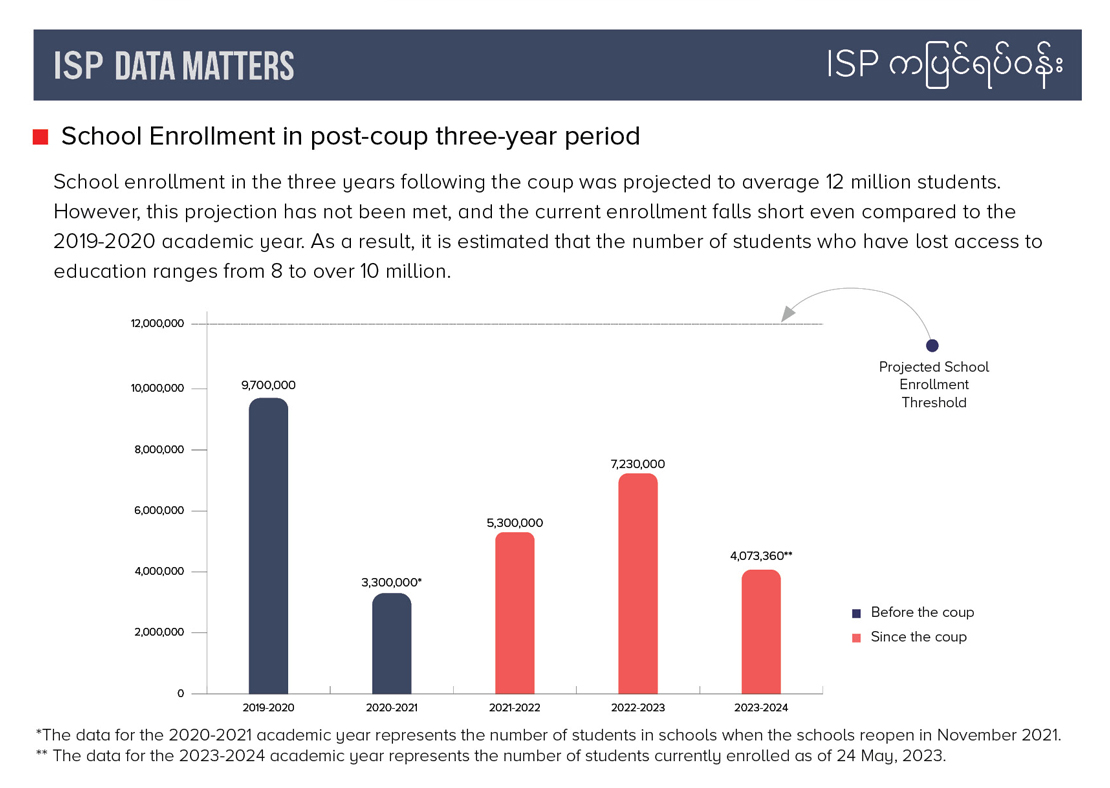

Prior to the commencement of the coming academic year, the SAC enacted a private education law on May 12, imposing more restrictions on private schools and schools teaching international curricula. The law mainly prohibits the teaching of politics in the classroom and bans any political discussion, aiming to prevent any religious or political influences emerging within the classroom. The law includes strict penalties for non-compliance. Additionally, the law seeks to prohibit teachers and senior students who have participated in the Civil Disobedience Movement (CDM) from teaching at private schools. This new legislation appears to prioritize control rather than fostering the development and creativity of the youth. Its provisions serve to impose greater authority over educational institutions.
Around the same period, it has come to light that the opposition National Unity Consultative Council (NUCC) adopted a ‘Federal Democratic Education Policy’ on May 8. However, this policy appears to be somewhat ambiguous and primarily focuses on future prospects. While it mentions in good faith the creation of a future system, it does not provide clear guidance on which currently available schools children should be enrolled in, neither does it address the issue of ensuring a safe learning environment. Many children have already been deprived of education for two academic years, either due to their refusal to attend SAC schools or their inability to access programs offered by the National Unity Government’s program. At this time of upheaval, all stakeholders should carefully consider practical measures for managing these lost learning opportunities. It is imperative that these stakeholders prepare not only for short-term solutions but also for long-term considerations regarding the education of all children (See ISP What Matter No.25).
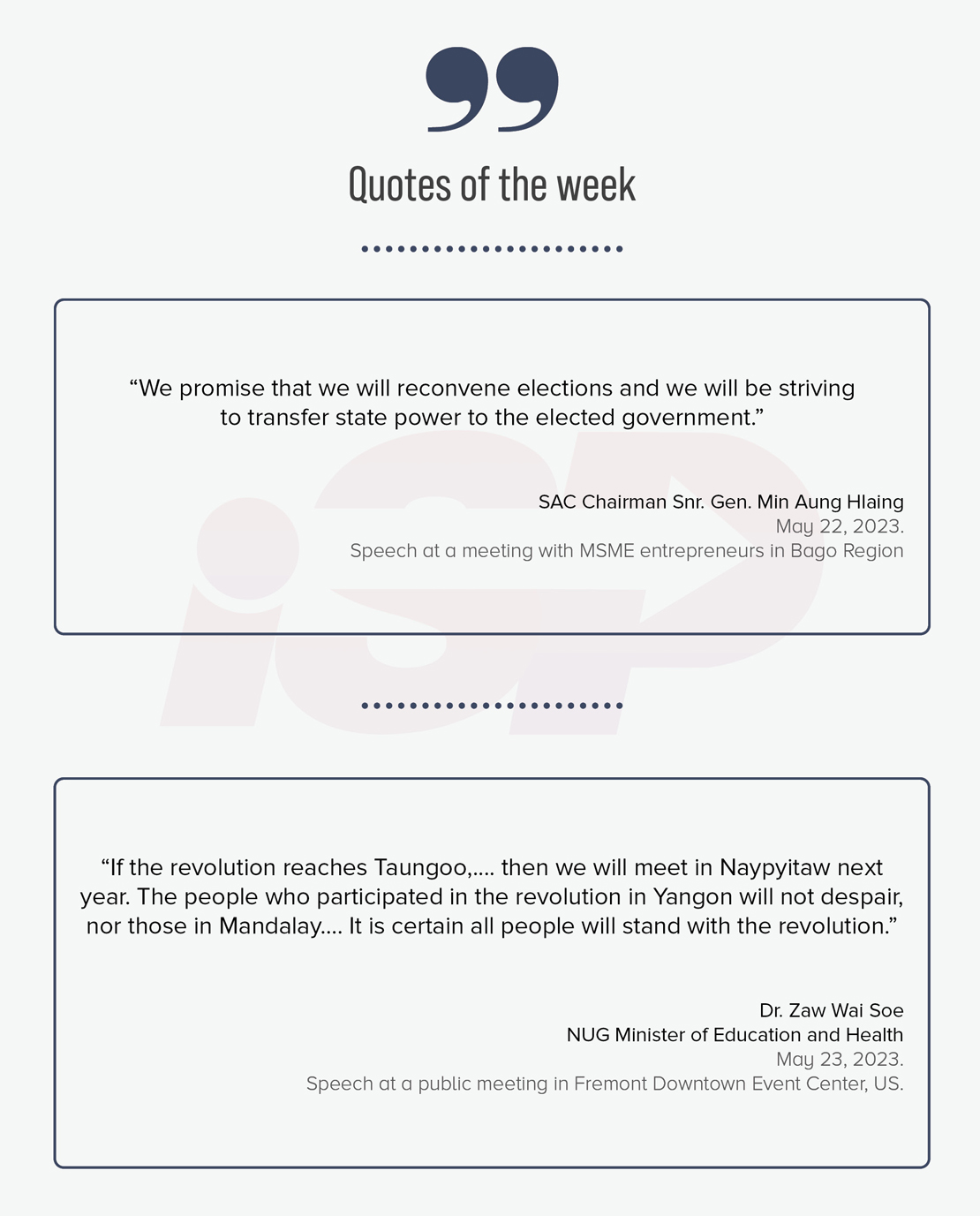
∎ Trends to be watched
Climate-change denialism
A recent report from AFP titled “Climate scientists flee Twitter as hostility surges” reports on the phenomenon of scientists that had been discussing and tweeting the development of climate change using scientific data, but who have more recently begun shying away from social media as they are increasingly suffering from insults and mass-spam incidents, including “offensive, personal, ad hominem attacks, and direct physical threats.” As a result, climate scientists’ tweets have been losing impact. The average number of likes they received was down 38% and average retweets fell 40%. Some scientists received responses from automated Chat Bots. “Climate communication on Twitter are less useful (now) given that I can see that my tweets are getting less engagement”, Andrew Dessler, professor of atmospheric sciences at Texas A&M University, said. Hostile forces have been systematically responding to climate scientists with negative views, contributing to a toxic environment for discussing climate-related topics.
The anticipated impacts of El Niño on Myanmar have received relatively little attention. The recent Super Cyclone Mocha has been seen by many people as a separate event. However, the World Meteorological Organization (WMO) had already issued a warning on May 3 saying “the unusually stubborn La Niña has now ended…The development of an El Niño will most likely lead to a new spike in global warming and increase the chance of breaking temperature records.”
“El Niño” is the warm phase of the El Niño-La Niña climate phenomenon. El Niño has an impact on heat waves, droughts, and forest fires. Heating the ocean results in greater evaporation leading to more intense storms, which can result in loss of freshwater resources, public health problems associated with disease outbreaks, and food insecurity. This phenomenon could last longer in this El Niño cycle. The Economic Intelligence Unit (EIU) reported that this El Niño event has already caused economic disruptions to India in 2023. El Niño could result in a more than a 0.6-percentage-point downward revision from India’s previous GDP forecast of 6.1 percent growth. The regional effects of El Niño could be widespread, particularly on the economies of agriculture-dependent countries.
It is important for policymakers and stakeholders to seriously consider natural phenomena such as El Niño and La Niña. Extreme weather conditions and climate change events can have serious impacts on the social, poverty, economic, and agricultural sectors in Myanmar. On the other hand, Myanmar’s capacity and organizational constraints have so far limited its effectiveness in responding to such natural events. The increasing frequency of extreme climate change events and natural disasters will continue to adversely affect Myanmar’s long-term economic growth prospects.
A 2019 report from the World Bank discussed possible scenarios of climate change in Myanmar. [Sutton, William, R. et al. (2019). Striking a Balance: Managing El Niño and La Niña in Myanmar’s Agriculture. The World Bank.] The World Bank (2019) report discussed Myanmar’s weak institutional capacity, poor governance, and low resilience to climate shocks. In addition, the importance of agriculture for Myanmar’s national economy and the fact that the both rural and poor polities are particularly vulnerable to climate crises. Moreover, the report pointed out that Myanmar lacks research capacity on the El Niño-La Niña Southern Oscillation (ENSO). The report’s recommendations suggest Myanmar should strengthen its Early Warning Systems (EWS) as the Department of Meteorology and Hydrology (DMH) should improve its EWS infrastructure and capacity to implement a fully effective EWS. Myanmar should also adopt a budgeting system that responds effectively to ENSO and should prepare human resources to respond to the possible effects of climate change.
The absence of overt threats does not diminish the significance of the situation. In Myanmar, a considerable number of individuals remain unaware of the looming threat of climate change. These individuals hold onto a status-quo mentality, resembling the mindset of climate change deniers.
∎ What ISP is reading?
Promoting ethnic peace or strengthening the state?
[Smith, Martin, and Jason Gelbort. (April 2023). The Nationwide Ceasefire Agreement in Myanmar: Promoting Ethnic Peace or Strengthening State. Amsterdam: Transnational Institute.]
Historians Martin Smith and Jason Gelbort recently published a 160 page report in regard to the Myanmar peace process. Martin Smith’s work on Burma [Burma: Insurgency and the Politics of Ethnicity] is likely the perfect textbook on the Myanmar conflict and many people will surely cite this work. In the report, the authors analyzed the Nationwide Ceasefire Agreement (NCA). As the report progresses, it focuses on the NCA and asks whether it would be “Promoting Ethnic Peace or Strengthening State.” The book is primarily a record of the recent history of Myanmar, seeing Myanmar’s reform process through the lens of the NCA. The authors discuss four important points arguing each was a factor which contributed to the failure of the NCA.
Looking at each of the four arguments sequentially, first, the persistent lack of clarity and inclusivity observed in the government-led peace initiatives. The NCA never lived up to its name of ‘national’ as numerous influential ethnic armed organizations (EAOs) have chosen to remain outside its bounds. For stance, the Northern EAOs of the Federal Political Negotiation and Consultative Committee (FPNCC) and an allied front, the United Nationalities Federal Council (UNFC) did not join the NCA.
Secondly, the NCA has failed to deliver any meaningful reform, particularly in terms of its implementation. Although numerous bodies and committees were established in accordance with the NCA, the national-level political dialogues prescribed by the agreement did not yield the desired outcomes. Furthermore, the Ceasefire Joint Monitoring Committee (JMC) has proven to be ineffective. Paradoxically, during a time of supposed peace-building, conflict and humanitarian emergencies have worsened in several parts of the country since the signing of the NCA in 2015. Since the 2015 NCA, the supposed ceasefire has not brought an end to hostilities, and intense battles have occurred, particularly in areas such as Kachin and Rakhine. As a result of these military stand-offs, many families find themselves trapped in a state of perpetual limbo, neither experiencing war nor enjoying true peace. Another important dimension of the NCA, the convergence of health and education initiatives between state and non-state actors, initially showed promise but has proven to be unsustainable in the long run.
The third important factor is the lack of political will, which has led to the NCA’s failure to deliver meaningful reforms. This lack of determination has resulted in the NCA’s inability to bring about effective security sector reform or significant political transformations. It has been unable to induce any notable behavioral changes within the Tatmadaw, Myanmar’s military. Finally, the fourth factor is that the NCA lacks any success stories or tangible evidence of progressive change. While it may have temporarily “frozen” certain conflicts, it has not provided a promising or historically transformative trajectory. Martin Smith has said that the “NCA itself is not a problem, but the contexts surrounding the NCA are problematic”. He also noted, “finally while learning from the past, it is also vital to take a forward-looking view.”


